 Picture: Inst. de Automatica Industrial (IAI)
Picture: Inst. de Automatica Industrial (IAI)
SILO6
Determined to improve the speed of walking robots, the creators of SILO4 figured that a robot can walk faster with more legs. This has led to the realization and creation of a hexapod robot called SILO6. Spain’s Industrial Automation Institute completed the project in 2004, again with the primary purpose of using it as a platform for robotic researches and studies.
Under a grant funded by Spain’s Ministry of Education and Science, the creators successfully utilized SILO6 in the detection of landmines. The project was thought of as an initiative to resolve a worldwide problem posed by the clearing of land mines that were deployed several decades back.
SILO6 was developed under the concept of the DYLEMA project breaking down the six-legged walking robot into five main subsystems: sensor head, manipulator, locator, the walking robot itself, and the controller.
The sensor is composed of a mine-detecting set. The most useful ones are those that are lightweight and those that can detect landmines with metal parts. The manipulator is designed to carry the landmine detector. The locator subsystem is composed of a magnetic compass, a GPS antenna, and a wi-fi antenna.
The walking robot provides the body that supports the other subsystems as it moves around a location. The controller is actually a remote computer used to control the robot and its subsystems. It has modules for man-machine interface run by Java, alarm database manager, and mobile robot communication.
Features of SILO6: